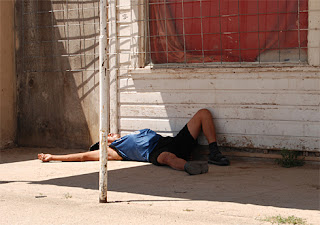On Tuesday, August 13, 2013, votes were cast by tribal members to determine the legalization of alcohol sales on the Pine Ridge Indian Reservation. The election results were very close - 1,843 in favor of legalization and 1,683 in opposition.
 |
| www.old-picture.com/indians/Indian-Invocation |
In the early-to-mid-1800s, British fur traders introduced whiskey, rum, and brandy (known as "fire water" because the high alcohol content could be lit on fire) to the Sioux, making them the last of the American Indian tribes to come into contact with alcohol. This late introduction was partially due to the fact that the Lakota and Dakota Sioux did not like to associate with white people, and also because the American expansion into the western plains happened late in history. However, as the Sioux became increasingly dependent upon the trading business, alcohol consumption became more prevalent in their culture and began to inflict cultural, spiritual, and social damage.
The Lakota who survived the wars, massacres, Small Pox epidemics, and bitter cold winters on the Northern Plains were herded onto reservations throughout South Dakota. After years of fighting, they now watched as their nomadic lifestyle, religion, language, and culture disappeared. Thrown into the confusing world of European colonialism, the warrior spirit was broken, forced into submission, and Lakota men, who had never before touched liquor, discovered a way to numb their pain. And new sicknesses appeared: despair, depression, and alcoholism.
With approximately one hundred fifty years of involvement with alcohol, I believe the Lakota are more susceptible to its intoxicating effects. Scientific studies have been conducted to substantiate this claim – livers have been dissected and compared – and the results have shown that there is no conclusive evidence to prove that an Indian metabolizes alcohol any differently than a non-Indian. If this is so, why do 63% of most American Indian tribes believe that Indians have a physiological or biological weakness to alcohol that non-Indians do not have? (American Indian and Alaska Native Mental Health Research). Could it be because they have witnessed it or experienced it first-hand? Sometimes familiarity is a better measurement for fact than a scientific study.
In 1645, the Connecticut Colony prohibited the sale of liquor to Indians because of the violent behavior that ensued after alcohol was consumed by the Indians. In 1832, the United States Congress passed a Federal law prohibiting the sale of liquor to “any and all American Indians.” This law was actually requested, and supported, by Indian leaders. In 1953, each tribe within the United States was given the right to regulate alcohol on their reservation. By 1974, only 31.4% of all US reservations had passed a law making the sale of alcohol legal within their borders. Tribes were never coerced into prohibition - they made the choice to keep poison away from their people.
 |
| Passed out in border town of White Clay, NE |
The inevitable increase in abuse, neglect, and suicide is a complex issue that deserves its own forum and I won’t expound upon that in this post, however, I would like to say that reports about the success of legalization of alcohol on the Rosebud Reservation are misleading. Ask the tribes First Responders, and those who work in the judicial system and at the hospital in Rosebud and they will tell you about the heartbreaking alcohol-related violence that occurs regularly.
 |
| Children's Shelter in Pine Ridge. Most are here because of alcohol-related abuse and neglect |

